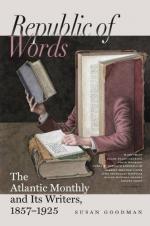From the bridge over the Avon, the road passes in front of the castle-gate, and soon enters the principal street of Warwick, a little beyond St. John’s School-House, already described. Chester itself, most antique of English towns, can hardly show quainter architectural shapes than many of the buildings that border this street. They are mostly of the timber-and-plaster kind, with bowed and decrepit ridge-poles, and a whole chronology of various patchwork in their walls; their low-browed door-ways open upon a sunken floor; their projecting stories peep, as it were, over one another’s shoulders, and rise into a multiplicity of peaked gables; they have curious windows, breaking out irregularly all over the house, some even in the roof, set in their own little peaks, opening lattice-wise, and furnished with twenty small panes of lozenge-shaped glass. The architecture of these edifices (a visible oaken framework, showing the whole skeleton of the house,—as if a man’s bones should be arranged on his outside, and his flesh seen through the interstices) is often imitated by modern builders, and with sufficiently picturesque effect. The objection is, that such houses, like all imitations of by-gone styles, have an air of affectation; they do not seem to be built in earnest; they are no better than playthings, or overgrown baby-houses, in which nobody should be expected to encounter the serious realities of either birth or death. Besides, originating nothing, we leave no fashions for another age to copy, when we ourselves shall have grown antique.
Old as it looks, all this portion of Warwick has overbrimmed, as it were, from the original settlement, being outside of the ancient wall. The street soon runs under an arched gateway, with a church or some other venerable structure above it, and admits us into the heart of the town. At one of my first visits, I witnessed a military display. A regiment of Warwickshire militia, probably commanded by the Earl, was going through its drill in the market-place; and on the collar of one of the officers was embroidered the Bear and Ragged Staff, which has been the cognizance of the Warwick earldom from time immemorial. The soldiers were sturdy young men, with the simple, stolid, yet kindly, faces of English rustics, looking exceedingly well in a body, but slouching into a yeoman-like carriage and appearance, the moment they were dismissed from drill. Squads of them were distributed everywhere about the streets, and sentinels were posted at various points; and I saw a sergeant, with a great key in his hand, (big enough to have been the key of the castle’s main entrance when the gate was thickest and heaviest,) apparently setting a guard. Thus, centuries after feudal times are past, we find warriors still gathering under the old castle-walls, and commanded by a feudal lord, just as in the days of the King-Maker, who, no doubt, often mustered his retainers in the same market-place where I beheld this modern regiment.




